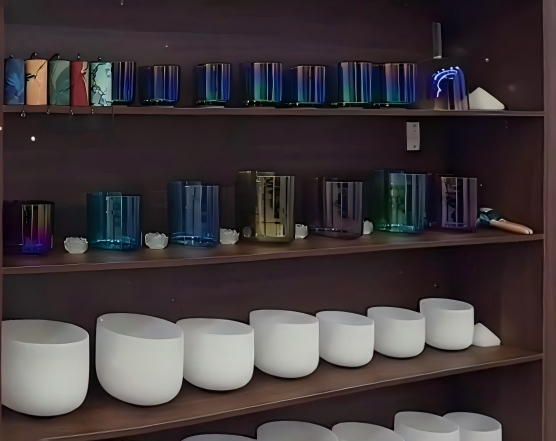The world of sound healing offers practitioners two distinct yet complementary pathways through the resonant voices of metal singing bowls and crystal healing bowls. These instruments, though serving similar therapeutic purposes, represent different approaches to vibrational healing—one rooted in ancient tradition and craftsmanship, the other born from modern technology and precision engineering. Understanding their unique characteristics empowers practitioners to make informed choices that align with their healing intentions, personal preferences, and practical needs.
Both types of bowls harness the fundamental principle that sound vibrations can influence our physical, emotional, mental, and spiritual well-being, yet they achieve this through markedly different acoustic signatures and energetic qualities. The choice between metal and crystal bowls often reflects deeper questions about tradition versus innovation, complexity versus simplicity, and the role of craftsmanship versus precision in healing tools.
As sound healing continues to evolve and integrate with modern wellness practices, practitioners benefit from understanding not only how these instruments differ but also how they might complement each other in comprehensive healing approaches that honor both ancient wisdom and contemporary insights into the science of vibrational medicine.

Metal Singing Bowls Fundamentals
Historical Origins and Cultural Heritage
Metal singing bowls trace their origins to the Himalayan regions over a thousand years ago, emerging from sophisticated metallurgical traditions that combined practical craftsmanship with spiritual understanding. These sacred instruments developed within Buddhist monastic communities across Tibet, Nepal, Bhutan, and northern India, where they served multiple functions ranging from meditation support to ceremonial use and community coordination.
The traditional creation of metal singing bowls involved master craftspeople who understood not only the technical aspects of metallurgy but also the spiritual significance of creating instruments capable of facilitating consciousness transformation. These artisans passed down their knowledge through generations of apprenticeship, maintaining quality standards and spiritual intentions that ensured each bowl would serve as an effective tool for healing and spiritual practice.
Buddhist monasteries integrated singing bowls into daily routines, using them to mark meditation periods, call communities to gather, and create acoustic environments conducive to contemplative states and spiritual development. The bowls’ gentle yet penetrating tones provided ideal focal points for developing concentration while supporting the peaceful atmosphere necessary for sustained spiritual practice.
The introduction of metal singing bowls to Western cultures during the 20th century coincided with growing interest in Eastern spirituality and alternative healing modalities, leading to widespread adoption in meditation centers, wellness practices, and therapeutic applications that honor their traditional spiritual functions while adapting them to contemporary healing needs and scientific understanding.
Material Composition and Crafting Methods
Traditional metal singing bowls were crafted from seven sacred metals, each corresponding to celestial bodies and their associated energetic qualities according to ancient astrological and alchemical understanding. Gold (Sun), silver (Moon), mercury (Mercury), copper (Venus), iron (Mars), tin (Jupiter), and lead (Saturn) were combined in specific proportions believed to create instruments capable of harmonizing with both cosmic and human energy systems.
Modern metal bowls often utilize bronze or brass alloys that provide excellent acoustic properties while meeting contemporary safety and availability requirements. These alloys can produce bowls with remarkable tonal qualities and healing effectiveness, demonstrating that the spiritual and therapeutic value of singing bowls depends more on acoustic excellence and crafting intention than on specific metal compositions.
The traditional hand-forging process involved heating metals to precise temperatures, hammering them into shape with carefully controlled force and rhythm, and gradually refining the bowl’s proportions to achieve desired acoustic characteristics. This labor-intensive process required deep understanding of how metal thickness, curve, and surface texture affect resonance, sustain, and harmonic complexity.
Contemporary manufacturing methods range from continued hand-forging by traditional craftspeople to machine-assisted production that can achieve consistent quality and precise specifications. Both approaches can produce excellent instruments, though hand-forged bowls often possess unique acoustic characteristics and subtle variations that many practitioners find particularly appealing for healing work.
Acoustic Properties Analysis
Metal singing bowls produce complex acoustic signatures characterized by rich harmonic content, extended sustain, and warm, resonant tones that create immersive sound environments conducive to deep relaxation and healing states. The fundamental frequency combines with multiple overtones and harmonics to create layered acoustic experiences that engage listeners on multiple levels simultaneously.
The size and proportions of metal bowls determine their fundamental frequency and acoustic character, with larger bowls typically producing lower, more grounding tones suitable for physical and emotional healing, while smaller bowls generate higher frequencies that may support mental clarity and spiritual awareness. The relationship between bowl dimensions and acoustic output follows mathematical principles that create natural harmonic relationships.
Harmonic complexity in metal bowls results from the interaction between multiple vibrational modes within the metal structure, creating rich overtone series that evolve throughout the duration of each tone. This acoustic complexity provides therapeutic depth and engagement that many practitioners find particularly effective for working with complex emotional states and facilitating profound healing experiences.
The sustain characteristics of metal bowls allow tones to develop and evolve over extended periods, providing opportunities for deep listening and gradual entrainment of consciousness toward healing states. The natural decay patterns of metal bowl tones often mirror the breathing rhythms and neural oscillations associated with relaxation and meditation, supporting natural healing processes.
Crystal Healing Bowls Characteristics
Development History and Modern Applications
Crystal healing bowls represent a relatively recent innovation in sound healing, emerging during the late 20th century as advances in materials science and manufacturing technology made it possible to create musical instruments from pure quartz crystal. These bowls developed from industrial applications of quartz technology, where the piezoelectric properties of crystal were harnessed for precision timekeeping and electronic applications.
The adaptation of crystal technology for healing purposes reflected growing interest in combining ancient healing wisdom with modern scientific understanding of vibrational medicine and crystal properties. Early crystal bowl makers experimented with various crystal compositions and manufacturing techniques to create instruments specifically designed for therapeutic and spiritual applications.
Modern crystal bowl production utilizes high-temperature furnaces to melt pure quartz sand into precise molds, creating instruments with consistent acoustic properties and reliable tuning accuracy. This manufacturing precision allows for the creation of complete sets of bowls tuned to specific frequencies, scales, or chakra correspondences with remarkable accuracy and consistency.
The commercial development of crystal healing bowls has made these instruments widely accessible to practitioners worldwide, leading to rapid adoption in healing practices, meditation centers, and wellness facilities that appreciate their precise tuning, reliable quality, and distinctive acoustic characteristics.
Material Properties and Manufacturing Process
Crystal healing bowls are typically manufactured from pure quartz (silicon dioxide), a crystalline form of silica that possesses unique acoustic and energetic properties. Quartz crystal’s natural piezoelectric characteristics allow it to convert mechanical pressure into electrical energy and vice versa, creating instruments that respond sensitively to vibration while maintaining structural stability and acoustic consistency.
The manufacturing process begins with high-purity quartz sand that is heated to approximately 4000 degrees Fahrenheit in specialized furnaces, melting the crystalline structure into a moldable form that can be shaped into bowl configurations. This extreme temperature treatment creates instruments with uniform density and acoustic properties while maintaining the essential molecular structure that gives crystal its distinctive characteristics.
Precision molding techniques allow manufacturers to create bowls with exact specifications for size, wall thickness, and acoustic properties, resulting in instruments that can be tuned to precise frequencies with remarkable accuracy. This manufacturing precision enables the creation of complete sets of bowls that maintain perfect pitch relationships and consistent acoustic quality across different sizes and frequencies.
Quality control processes ensure that finished crystal bowls meet strict standards for structural integrity, acoustic performance, and tuning accuracy, resulting in instruments that maintain their properties over extended periods of use while providing reliable therapeutic performance for both practitioners and recipients.
Acoustic Characteristics and Energetic Properties
Crystal healing bowls produce pure, clear tones with simple harmonic structures that emphasize fundamental frequencies while minimizing complex overtones and harmonic distortion. This acoustic purity creates penetrating sounds that can travel great distances while maintaining clarity and precision, making crystal bowls particularly effective for applications requiring precise frequency delivery.
The acoustic simplicity of crystal bowls allows for exact tuning to specific frequencies, making them ideal for applications that require precise chakra correspondences, musical intervals, or therapeutic frequency protocols. This tuning precision enables practitioners to work with specific frequency ranges known to affect particular physiological or psychological processes.
Extended sustain capabilities allow crystal bowl tones to continue for remarkably long periods, often exceeding the sustain of comparable metal bowls while maintaining acoustic purity and frequency stability throughout the entire duration. This extended resonance provides opportunities for deep entrainment and prolonged exposure to specific healing frequencies.
The energetic properties attributed to crystal bowls draw from traditional crystal healing concepts that suggest quartz crystal can amplify, focus, and transmit energy while maintaining informational clarity and purity. While these properties remain subjects of ongoing investigation, many practitioners report distinctive energetic sensations and healing responses when working with crystal bowls compared to other instruments.
Material Difference Comparative Analysis
Physical Properties Comparison
Metal and crystal bowls differ significantly in weight, with metal bowls typically being substantially heavier due to the higher density of metal alloys compared to quartz crystal. This weight difference affects portability, setup requirements, and the physical sensation of handling the instruments, with metal bowls providing more substantial tactile feedback while crystal bowls offer greater ease of transport and positioning.
Durability characteristics vary considerably between the two materials, with metal bowls generally offering superior resistance to impact damage and stress fractures, while crystal bowls require more careful handling due to their brittle nature and susceptibility to cracking or shattering if dropped or subjected to sudden temperature changes or physical stress.
Temperature sensitivity affects the acoustic properties of both materials differently, with metal bowls experiencing pitch changes due to thermal expansion and contraction, while crystal bowls maintain relatively stable tuning across temperature variations. This stability makes crystal bowls particularly suitable for applications requiring consistent frequency delivery regardless of environmental conditions.
Surface characteristics influence both acoustic properties and maintenance requirements, with metal bowls developing patina and oxidation over time that may affect their appearance but typically enhances their acoustic warmth, while crystal bowls maintain their transparency and pristine appearance with minimal maintenance while requiring protection from scratches and impact damage.
Acoustic Performance Comparison
Tonal quality represents one of the most significant differences between metal and crystal bowls, with metal instruments producing warm, rich tones characterized by complex harmonic content and organic acoustic textures, while crystal bowls generate pure, clear tones with simple harmonic structures and precise frequency content that emphasizes clarity over complexity.
Harmonic complexity varies dramatically between the two materials, with metal bowls producing multiple overtones and harmonics that create layered acoustic experiences appealing to listeners who appreciate textural richness and acoustic depth, while crystal bowls focus on fundamental frequencies with minimal harmonic coloration that appeals to practitioners seeking precise frequency delivery.
Volume projection capabilities differ substantially, with metal bowls often providing more focused acoustic projection suitable for intimate settings and personal practice, while crystal bowls can generate higher volume levels and greater spatial coverage, making them effective for larger groups and open spaces requiring broad acoustic distribution.
Playing technique adaptability varies between the materials, with metal bowls responding to a wide range of playing techniques including various striking methods, rim singing approaches, and dynamic variations, while crystal bowls typically respond best to consistent, gentle techniques that preserve their acoustic purity and structural integrity.
Energetic Attributes Comparison
Traditional energetic associations reflect the cultural and spiritual contexts from which each instrument type emerged, with metal bowls carrying associations with planetary energies, alchemical traditions, and Buddhist spiritual practices, while crystal bowls connect with earth energies, mineral healing traditions, and contemporary crystal healing methodologies.
Modern energetic understanding focuses on the vibrational characteristics and acoustic properties of each material type, with metal bowls appreciated for their complex frequency content and organic acoustic evolution, while crystal bowls are valued for their frequency precision and acoustic purity that allows for targeted vibrational applications.
Individual sensitivity variations affect how practitioners and recipients respond to each instrument type, with some individuals finding metal bowls more emotionally resonant and spiritually meaningful, while others respond more strongly to the clarity and precision of crystal bowls, suggesting that personal constitution and preference play crucial roles in instrument selection.
Therapeutic application effectiveness depends largely on matching instrument characteristics with specific healing objectives and individual needs, with metal bowls often proving effective for emotional release and spiritual development work, while crystal bowls may be preferred for applications requiring precise frequency therapy and mental clarity enhancement.
In-depth Sound Quality and Tone Comparison

Detailed Tonal Characteristics Analysis
Metal singing bowls produce tones characterized by warmth, depth, and organic complexity that many practitioners describe as emotionally engaging and spiritually evocative. The fundamental frequency combines with rich overtones to create acoustic experiences that seem to unfold and develop over time, revealing subtle details and harmonic relationships that reward careful listening and support contemplative states.
Crystal healing bowls generate tones notable for their clarity, purity, and penetrating quality that cuts through ambient sound while maintaining precise frequency content. The acoustic simplicity creates focused listening experiences that direct attention to specific frequency ranges while minimizing harmonic distractions that might interfere with targeted therapeutic applications.
Subjective listening experiences vary significantly between the two instrument types, with metal bowls often evoking feelings of groundedness, emotional warmth, and spiritual connection that resonate with practitioners seeking traditional healing approaches, while crystal bowls may inspire feelings of clarity, transcendence, and energetic activation that appeal to those drawn to contemporary healing methodologies.
Objective acoustic measurements reveal distinct differences in frequency spectrum, harmonic content, and acoustic behavior, with metal bowls showing complex harmonic structures and gradual acoustic evolution, while crystal bowls demonstrate simple harmonic content and stable acoustic characteristics that maintain consistency throughout their duration.
Performance Expression Comparison
Dynamic control capabilities differ substantially between metal and crystal bowls, with metal instruments offering extensive opportunities for volume variation, tonal shaping, and expressive playing techniques that allow practitioners to create sophisticated acoustic journeys and responsive healing sessions, while crystal bowls typically provide more limited dynamic range but compensate with precision and consistency.
Technical versatility varies considerably, with metal bowls supporting diverse playing approaches including multiple striking techniques, various rim singing methods, complex multi-bowl arrangements, and creative sound effect generation, while crystal bowls excel in applications requiring precise frequency delivery, extended sustain, and acoustic purity but offer fewer options for technical variation.
Improvisational adaptability reflects the different acoustic characters of each instrument type, with metal bowls supporting spontaneous creative expression, emotional responsiveness, and musical development that can evolve organically during healing sessions, while crystal bowls provide reliable acoustic platforms for structured therapeutic protocols and predetermined frequency applications.
Learning curve differences affect how quickly practitioners can develop proficiency with each instrument type, with metal bowls requiring more extensive technical development to achieve optimal results but offering greater long-term potential for artistic and therapeutic expression, while crystal bowls provide more immediate accessibility but may offer less scope for advanced technical development.
Sound Propagation and Environmental Adaptation
Indoor acoustic performance varies between metal and crystal bowls depending on room characteristics, with metal bowls often benefiting from reverberant spaces that enhance their harmonic complexity while crystal bowls may perform better in acoustically controlled environments that preserve their frequency precision and acoustic clarity.
Outdoor usage effectiveness depends on environmental conditions and application requirements, with metal bowls typically providing more intimate acoustic experiences suitable for personal practice and small groups, while crystal bowls offer greater projection capabilities and environmental adaptability for larger gatherings and challenging acoustic conditions.
Group application differences reflect the distinct acoustic characteristics of each instrument type, with metal bowls creating shared acoustic environments that encourage emotional connection and collective experience, while crystal bowls provide clear acoustic focal points that support individual healing work within group settings.
Recording and reproduction considerations affect how well each instrument type translates through audio systems, with metal bowls often requiring careful microphone placement and acoustic treatment to capture their harmonic complexity, while crystal bowls typically record more easily but may lose some of their energetic impact through electronic reproduction.
Healing Effects and Application Scenarios Comparison
Personal Healing Applications
Meditation practice support varies significantly between metal and crystal bowls, with metal instruments often facilitating deep, introspective meditation states that encourage emotional processing and spiritual insight, while crystal bowls may support focused, clear meditation experiences that emphasize mental clarity and energetic awareness.
Stress relief effectiveness depends on individual preferences and stress patterns, with metal bowls providing comprehensive acoustic environments that address multiple stress factors simultaneously, while crystal bowls offer targeted frequency applications that may be particularly effective for specific stress-related symptoms and acute tension patterns.
Energy regulation functions reflect the different acoustic approaches of each instrument type, with metal bowls supporting gradual, organic energy shifts that honor natural healing rhythms, while crystal bowls enable precise energy adjustments that can address specific energetic imbalances with focused frequency applications.
Sleep quality improvement potential varies based on individual sleep patterns and acoustic preferences, with metal bowls often providing gentle, nurturing acoustic environments that support natural sleep rhythms, while crystal bowls may be effective for specific sleep-related applications but require careful volume and frequency selection to avoid overstimulation.
Professional Healing Service Applications
Therapist preference factors include training background, client demographics, therapeutic objectives, and personal acoustic preferences that influence instrument selection for professional healing work. Many practitioners develop expertise with both instrument types to provide comprehensive therapeutic options that can address diverse client needs and healing objectives.
Clinical application differences reflect the distinct therapeutic characteristics of each instrument type, with metal bowls often used for emotional healing, trauma work, and spiritual development applications, while crystal bowls may be preferred for energy healing, chakra balancing, and applications requiring precise frequency protocols.
Group healing activities benefit differently from each instrument type, with metal bowls creating inclusive acoustic environments that encourage group bonding and collective healing experiences, while crystal bowls provide clear acoustic leadership that can guide group attention and facilitate coordinated healing processes.
Training and education applications vary based on learning objectives and student needs, with metal bowls offering comprehensive training opportunities in traditional healing approaches and complex acoustic techniques, while crystal bowls provide excellent platforms for learning frequency-based healing methods and precision acoustic applications.
Special Application Scenarios
Children’s healing applications require careful consideration of instrument characteristics and safety factors, with both metal and crystal bowls offering unique benefits when used appropriately. Metal bowls may provide more engaging acoustic experiences that capture children’s attention, while crystal bowls offer gentler, more predictable acoustic outputs that may be less overwhelming for sensitive young listeners.
Elderly care applications benefit from the distinct characteristics of each instrument type, with metal bowls often providing familiar, comforting acoustic experiences that connect with traditional healing approaches, while crystal bowls may offer precise, gentle stimulation that can support cognitive function and emotional well-being without overwhelming sensitive nervous systems.
Special needs populations may respond differently to each instrument type based on their specific sensitivities and therapeutic requirements. Metal bowls provide complex acoustic stimulation that may benefit individuals with certain neurological conditions, while crystal bowls offer clear, simple acoustic inputs that may be more appropriate for individuals with sensory processing challenges.
Environmental applications in healthcare, educational, and workplace settings require consideration of acoustic properties, safety factors, and practical implementation requirements that may favor one instrument type over another depending on specific organizational needs and user populations.
Selection Guidelines and Usage Recommendations
Personal Needs Assessment
Usage purpose clarification helps determine which instrument type better serves individual healing objectives, with metal bowls typically preferred for traditional spiritual practices, emotional healing work, and comprehensive wellness applications, while crystal bowls may be selected for precision frequency therapy, chakra balancing, and contemporary healing approaches.
Experience level considerations affect instrument selection recommendations, with beginners often finding crystal bowls more accessible due to their consistent acoustic properties and simpler playing techniques, while experienced practitioners may appreciate the complexity and versatility offered by metal bowls for advanced healing applications.
Budget analysis involves comparing initial costs, long-term value, and potential return on investment for each instrument type. While prices vary widely within each category, practitioners should consider not only purchase price but also durability, versatility, and potential for skill development when evaluating economic factors.
Environmental assessment includes consideration of available space, acoustic conditions, storage requirements, and usage frequency that may influence the practicality of each instrument type for specific living and working situations.
Product Quality Assessment Standards
Metal bowl quality indicators include alloy composition, craftsmanship level, acoustic properties, and structural integrity that determine both immediate performance and long-term value. High-quality metal bowls demonstrate consistent wall thickness, smooth surface finish, rich harmonic content, and extended sustain that supports effective healing applications.
Crystal bowl quality standards focus on quartz purity, manufacturing precision, tuning accuracy, and structural soundness that ensure reliable performance and safety. Premium crystal bowls exhibit clear transparency, precise frequency accuracy, extended sustain, and resistance to structural flaws that could affect performance or safety.
Brand reputation considerations include manufacturer background, market feedback, quality consistency, and customer service quality that affect both initial purchase satisfaction and long-term ownership experience. Established manufacturers with strong reputations typically provide better quality assurance and customer support.
Value assessment involves balancing price considerations with quality factors, performance characteristics, and expected longevity to determine the best investment for individual needs and circumstances. Higher-quality instruments typically provide better long-term value despite higher initial costs.
Usage Techniques and Maintenance
Basic usage methods require understanding proper handling, playing techniques, safety considerations, and optimization strategies specific to each instrument type. Metal bowls typically require more technique development but offer greater expressive possibilities, while crystal bowls provide more immediate accessibility but require careful handling.
Maintenance and care guidelines differ significantly between metal and crystal bowls, with metal instruments requiring protection from corrosion and impact damage while benefiting from gentle cleaning and proper storage, while crystal bowls need protection from impacts and temperature extremes while requiring minimal routine maintenance.
Advanced application techniques enable practitioners to maximize the therapeutic potential of each instrument type through sophisticated playing methods, combination strategies, and integration with other healing modalities. Continued skill development enhances both personal practice and professional service quality.
Problem resolution guidance helps practitioners address common issues including acoustic problems, maintenance concerns, and performance optimization that may arise during regular use. Understanding troubleshooting approaches prevents minor issues from becoming major problems while maintaining optimal instrument performance.
Conclusion and Selection Recommendations
Instrument Characteristics Summary
Metal singing bowls offer traditional wisdom, acoustic complexity, expressive versatility, and emotional depth that appeal to practitioners seeking comprehensive healing tools rooted in ancient spiritual traditions. Their rich harmonic content, warm tonal qualities, and diverse playing techniques provide extensive opportunities for personal and professional healing applications that honor both traditional approaches and contemporary therapeutic needs.
Crystal healing bowls provide modern precision, acoustic clarity, frequency accuracy, and energetic purity that appeal to practitioners seeking focused therapeutic tools based on contemporary understanding of vibrational medicine. Their clear tonal qualities, extended sustain, and reliable acoustic properties support targeted healing applications that emphasize precision and consistency.
Complementary recognition acknowledges that both instrument types offer unique value and can work together synergistically in comprehensive healing approaches that draw from both traditional wisdom and modern innovation. Many practitioners find that combining metal and crystal bowls provides more complete therapeutic options than relying exclusively on either type.
Personal choice importance emphasizes that individual preferences, healing objectives, and practical considerations ultimately determine the most appropriate instrument selection for each practitioner. Neither instrument type is inherently superior; rather, each serves different needs and preferences within the diverse landscape of sound healing applications.
Specific Selection Recommendations
Beginner practitioners often benefit from starting with crystal bowls due to their accessibility, consistent performance, and immediate results, while gradually developing skills that may later support effective use of metal bowls for more complex applications. This progression allows skill development while minimizing initial frustration and investment risk.
Professional practitioners typically benefit from acquiring both instrument types to provide comprehensive service options that can address diverse client needs and therapeutic objectives. Professional applications often require flexibility and adaptability that benefit from access to both traditional and contemporary healing tools.
Special needs groups require individualized assessment and possibly customized solutions that consider specific sensitivities, therapeutic requirements, and safety factors. Professional guidance may be valuable for selecting appropriate instruments for work with vulnerable populations or complex therapeutic situations.
Combination purchase strategies allow practitioners to build comprehensive instrument collections gradually while spreading costs over time and gaining experience with different instrument types. Thoughtful acquisition planning can provide maximum therapeutic value while managing financial investment effectively.
Future Development Outlook
Technical innovation continues advancing both metal and crystal bowl manufacturing through improved materials, enhanced precision, and innovative design approaches that expand therapeutic possibilities while maintaining traditional effectiveness. Future developments may bridge the gap between traditional and contemporary approaches through hybrid technologies and novel applications.
Market development trends indicate growing acceptance and integration of sound healing in mainstream healthcare, wellness, and educational settings that create expanding opportunities for both metal and crystal bowl applications. Professional practitioners may find increasing demand for sound healing services across diverse sectors.
Application expansion includes integration with medical treatments, educational programs, workplace wellness initiatives, and community health services that require practitioners skilled in both traditional and contemporary healing approaches. Cross-disciplinary collaboration may create new opportunities for sound healing applications.
Cultural preservation efforts ensure that traditional metal bowl craftsmanship and spiritual applications continue alongside modern innovations, maintaining the wisdom and effectiveness of ancient healing practices while embracing beneficial contemporary developments. This balance honors both heritage and innovation in service of optimal healing outcomes.
The choice between metal singing bowls and crystal healing bowls ultimately reflects each practitioner’s unique combination of healing philosophy, practical needs, aesthetic preferences, and professional requirements. Both instrument types offer profound healing potential when selected thoughtfully and used skillfully, contributing to the rich tapestry of sound healing modalities available to support human wellness and spiritual development in our contemporary world.
Understanding the distinctive characteristics, applications, and benefits of each instrument type empowers practitioners to make informed decisions that serve their highest healing purposes while honoring both the ancient wisdom and modern insights that continue to advance the field of vibrational medicine for the benefit of all who seek healing through the transformative power of sound.







